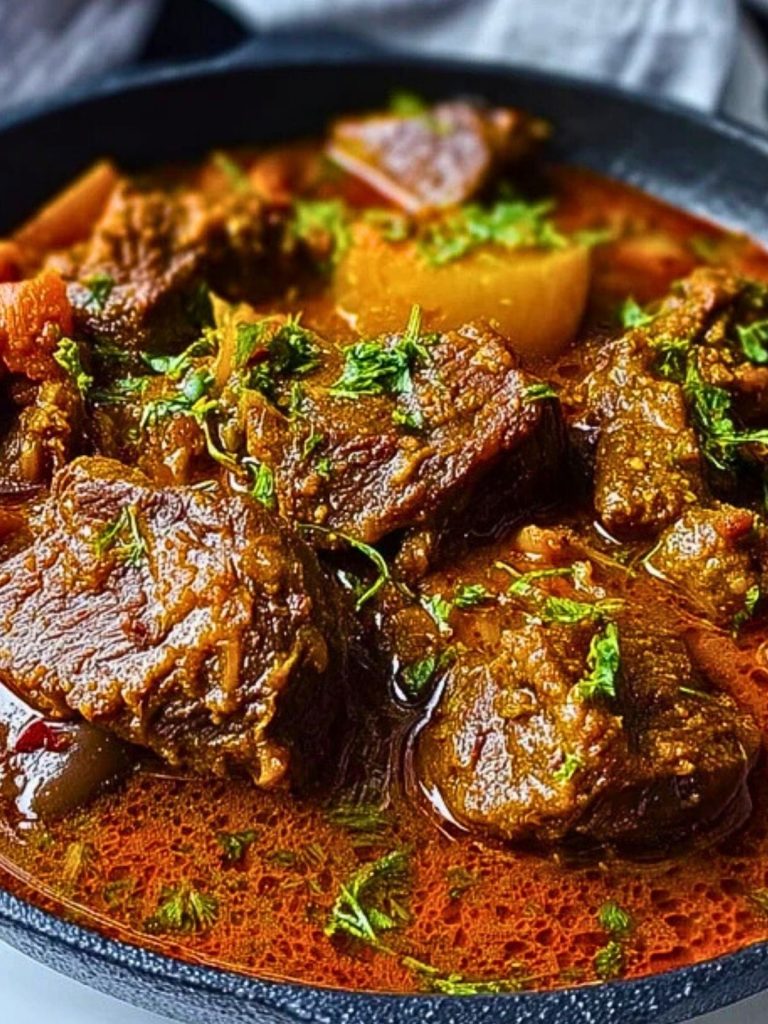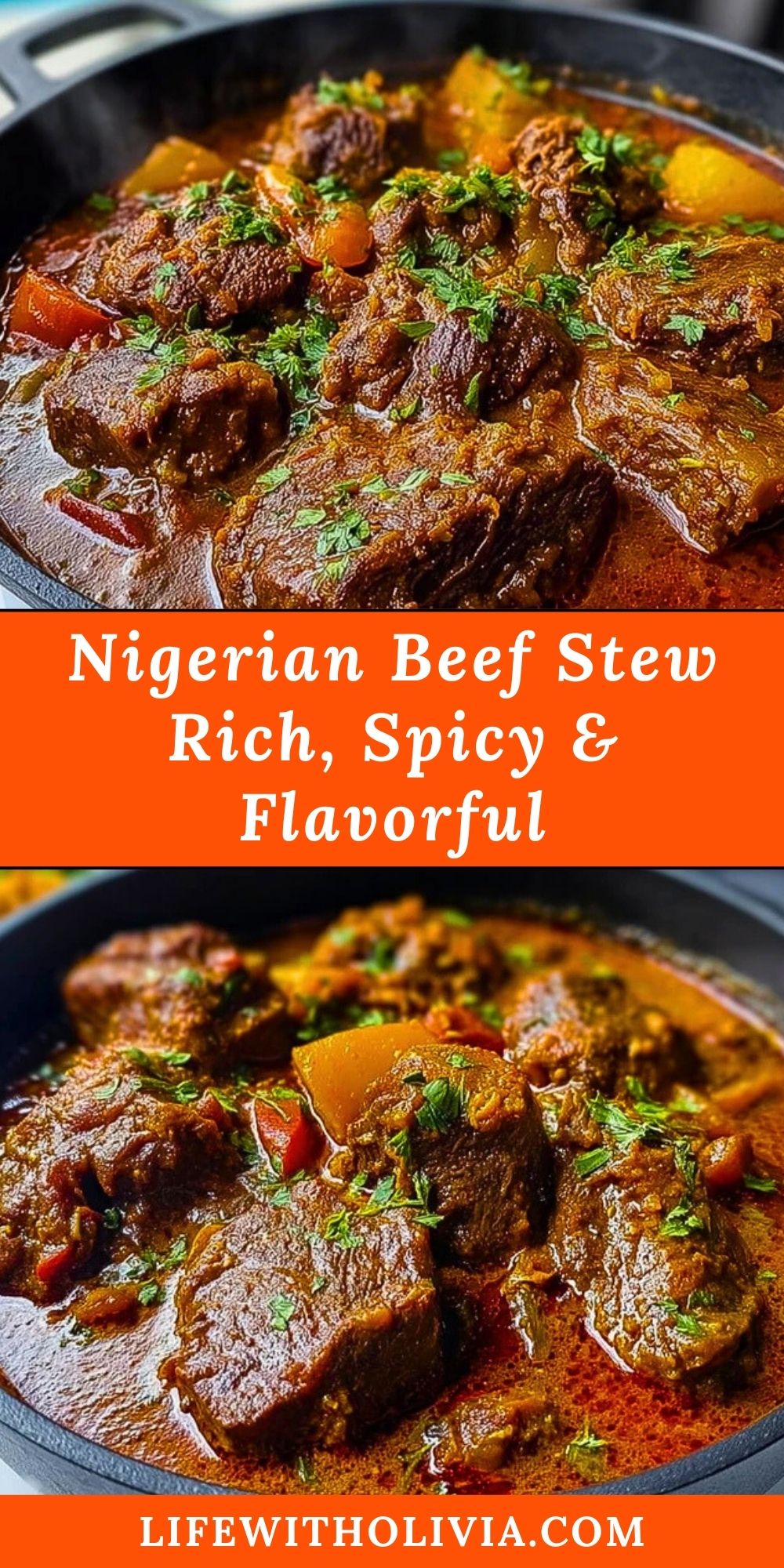If you’re craving something hearty, bold, and full of spice, Nigerian Beef Stew is your perfect comfort dish. This classic West African favorite is beloved for its deep, spicy tomato base, tender beef chunks, and an aroma that instantly fills your kitchen with warmth. Whether served over rice, with plantains, or scooped up with soft bread, it’s always a crowd-pleaser.
What makes Nigerian Beef Stew stand out is the fusion of bold spices and slow cooking that transforms simple ingredients into a rich, flavor-packed dish. Each bite bursts with layers of tomato, ginger, garlic, and a touch of fiery scotch bonnet peppers. It’s the kind of meal that becomes a family favorite with just one taste.
Preparation Phase & Tools to Use
To make the perfect Nigerian Beef Stew, preparation and the right tools are key. Here’s what you’ll need:
- Heavy-bottom pot or Dutch oven: This helps distribute heat evenly and prevents burning the tomato base.
- Blender or food processor: Crucial for achieving a smooth tomato-pepper mixture that forms the stew’s base.
- Tongs or slotted spoon: Useful for browning beef without splashing or sticking.
- Sharp knife and chopping board: Essential for prepping meat and veggies quickly and safely.
- Wooden spoon: For stirring the stew consistently and gently as it simmers to prevent sticking.
Taking time to brown the meat and blend your pepper mix smoothly makes all the difference. With your tools ready and your ingredients prepped, you’re halfway to creating a delicious pot of Nigerian Beef Stew.


Ingredients for the Nigerian Beef Stew
Every component in Nigerian Beef Stew plays a vital role in building its robust flavor and texture. Here’s what you’ll need and why each one matters:
- Beef (stew cuts or bone-in): The heart of the stew. Bone-in beef adds extra flavor to the broth while creating juicy, tender bites.
- Tomatoes (fresh or canned): The base of the stew. Tomatoes bring acidity and a natural sweetness that balances the spices.
- Red bell peppers: Adds sweetness and color to the stew. They also mellow out the heat from the scotch bonnet.
- Scotch bonnet peppers: For that signature West African heat. Use sparingly if you prefer milder flavors.
- Onions: Used both in the pepper blend and sautéed for depth. Onions give a rounded base flavor to the stew.
- Garlic and ginger: Essential aromatics that create warmth and an earthy backbone.
- Vegetable oil: Used for frying the meat and stew base. Palm oil can also be used for a traditional twist.
- Thyme and curry powder: Common spices in Nigerian stews. Thyme adds herbaceous notes, while curry powder brings warmth.
- Salt and bouillon (Maggi or Knorr): For seasoning and umami richness. These amplify all the other flavors.
How To Make the Nigerian Beef Stew
Step 1: Marinate and Cook the Beef
Start by seasoning your beef with salt, bouillon, garlic, and a touch of thyme. Let it marinate for at least 30 minutes. Then boil until tender, reserving the flavorful stock for later.
Step 2: Blend the Pepper Mix
In a blender, combine tomatoes, red bell peppers, scotch bonnet peppers, half an onion, and a bit of garlic. Blend until smooth. This forms the rich base of your stew.
Step 3: Fry the Beef
In a large pot, heat vegetable oil and brown the cooked beef on all sides. This adds a caramelized flavor and seals in moisture.
Step 4: Fry the Pepper Sauce
Using the same oil, sauté chopped onions until translucent. Pour in the blended pepper mix and cook on medium heat, stirring occasionally, until it reduces and thickens. This takes about 20–25 minutes.
Step 5: Season and Simmer
Add curry powder, thyme, bouillon cubes, and a bit of salt. Pour in the reserved beef stock and bring to a gentle boil. Return the fried beef to the pot and let it simmer for another 10–15 minutes until the flavors marry.
Step 6: Final Adjustments
Taste and adjust seasoning if needed. The stew should be thick, aromatic, and glistening with oil at the top—a signature sign it’s ready to serve.
Best Ways to Serve and Store Nigerian Beef Stew
Nigerian Beef Stew is incredibly versatile when it comes to serving. Traditionally, it’s spooned over steamed white rice or eaten with soft, fluffy yam or boiled plantains. If you’re feeling adventurous, try it with jollof rice for a double hit of tomato richness. Crusty bread or agege bread also make perfect vessels for scooping up every last bit.
For storing, allow the stew to cool completely before transferring it to airtight containers. It can be refrigerated for up to 5 days or frozen for up to 3 months. The flavors intensify as it sits, making leftovers even more delicious. Reheat gently over the stove or in the microwave, adding a splash of water or stock if needed.
Frequently Asked Questions
How spicy is Nigerian Beef Stew?
It depends on how many scotch bonnet peppers you use. You can control the heat easily by adjusting the amount. Removing the seeds also reduces the spice level.
Can I make it ahead of time?
Yes! In fact, it tastes even better the next day after the flavors have had time to develop. It’s an ideal make-ahead dish for busy weeknights or parties.
What cut of beef is best for this stew?
Bone-in cuts like short ribs or chuck give the stew a richer flavor, but boneless stew meat or brisket work well too. Just be sure to simmer until the meat is tender.
Can I use palm oil instead of vegetable oil?
Absolutely. Palm oil adds a deeper, earthier flavor that’s more traditional in many Nigerian kitchens.
Why is my stew too watery or thin?
Your pepper mix likely hasn’t reduced enough. Make sure to cook the sauce until it thickens and the oil begins to rise to the top.
Is this stew gluten-free?
Yes, it’s naturally gluten-free as long as the bouillon cubes you use are certified gluten-free.
Want More Savory Stew Ideas?
If this Nigerian Beef Stew warmed your soul, you’ll definitely want to try these other hearty meals from Life With Olivia:
- Easy Crockpot Brisket with Rich Gravy: A slow-cooked favorite perfect for Sundays.
- Flavorful Jailhouse Rice Recipe: A rice dish packed with ground beef and bold seasonings.
- Chicken Mushroom Stroganoff: Creamy and comforting, this is ideal for cozy nights.
- Baked Crab Legs in Butter Sauce: Seafood lovers, don’t miss this buttery indulgence.
- Sweet Garlic Chicken in the Crockpot: Sweet and savory chicken with effortless prep.
Save This Recipe for Later
📌 Save this recipe to your Pinterest dinner board so you can come back to it anytime: Life With Olivia on Pinterest.
And if you made this Nigerian Beef Stew, let me know how it turned out in the comments! Did you turn up the heat or dial it back? Try it with palm oil or stick to vegetable oil?
I love hearing how everyone adds their own twist. Your questions and stories are always welcome—let’s inspire each other in the kitchen.


Nigerian Beef Stew: Rich, Spicy & Flavorful
- Total Time: 1 hour 15 minutes
- Yield: 6 servings
Description
This Nigerian Beef Stew is a bold, spicy, and deeply savory dish made with tender chunks of beef simmered in a thick tomato and pepper sauce. Perfect over rice or plantains, it’s a classic comfort food in West African cuisine that’s rich in flavor and easy to prepare in large batches.
Ingredients
2 lbs beef (stew cuts or bone-in)
4 large tomatoes (fresh or canned)
2 red bell peppers
1–2 scotch bonnet peppers
2 large onions
4 cloves garlic
1 thumb-sized piece of ginger
1/2 cup vegetable oil
1 teaspoon thyme
1 teaspoon curry powder
2 bouillon cubes (Maggi or Knorr)
1 teaspoon salt (adjust to taste)
Instructions
1. Marinate the beef with salt, bouillon, garlic, and thyme. Let sit for 30 minutes, then boil until tender. Reserve the beef stock.
2. In a blender, combine tomatoes, bell peppers, scotch bonnet, half an onion, and garlic. Blend until smooth.
3. Heat oil in a pot, brown the cooked beef, and set aside.
4. In the same pot, sauté chopped onions until soft. Pour in the blended mix and cook for 20–25 minutes, stirring occasionally.
5. Add curry powder, thyme, bouillon, and salt. Stir, then add reserved stock and browned beef. Simmer for 10–15 minutes.
6. Taste and adjust seasoning. The stew should be thick with oil rising to the top. Serve hot.
Notes
For extra flavor, use bone-in beef or short ribs.
Be sure to let the pepper mix cook down fully before adding the beef—this ensures rich flavor and thick consistency.
Scotch bonnet is hot! Adjust quantity or remove seeds to control heat level.
- Prep Time: 30 minutes
- Cook Time: 45 minutes
- Category: Stew
- Method: Stovetop
- Cuisine: Nigerian
Nutrition
- Serving Size: 1 cup
- Calories: 410
- Sugar: 5g
- Sodium: 850mg
- Fat: 28g
- Saturated Fat: 7g
- Unsaturated Fat: 18g
- Trans Fat: 0g
- Carbohydrates: 10g
- Fiber: 3g
- Protein: 28g
- Cholesterol: 90mg
Keywords: beef stew, Nigerian food, tomato stew, spicy stew



